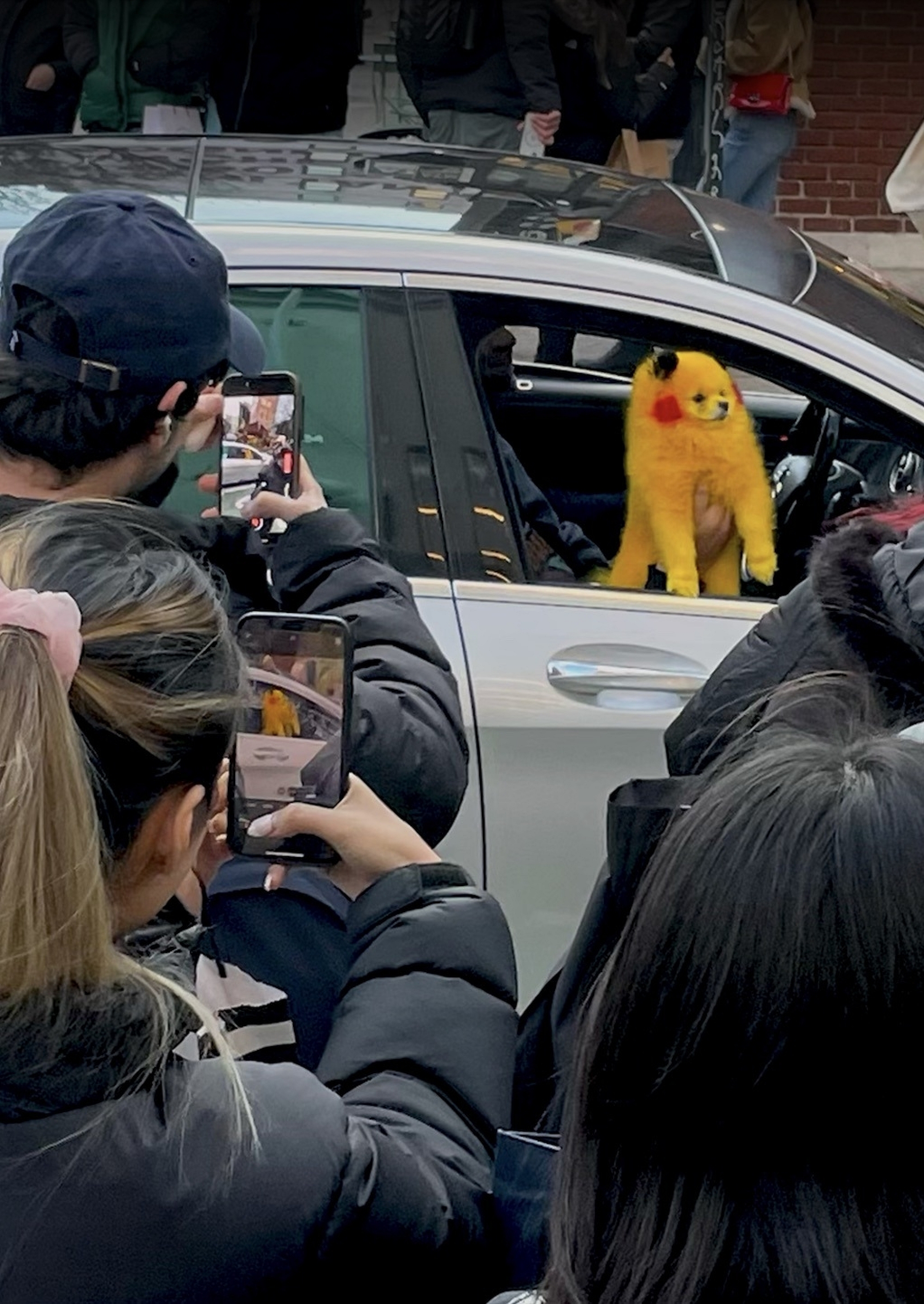
Text Clara Malley
In 2023, fandoms emerged as a powerful catalyst for breakthrough cultural moments, community connection, and even Richter Scales.
The culture-shifting power of fan communities isn’t new: The Beatles, the Juggalos, even MAGA (a nightmare dinner party list). But the mass adoption of the “fan” category by brands, platforms, politicians, and media outlets has become meaningless.
Is a TikTok hashtag-turned-Shein product category, like “Tomato Girl” really something you can be a fan of? Fandoms are where we find community, belonging, and a shared purpose. That goes out the window if you’re tying your identity to what is essentially a buzzy name used to categorize this month’s shopping cart. Defining the difference between fandom and Ephem-era will be crucial in differentiating what’s breaking through and what’s selling through in 2024 and beyond.
2023 made clear the creative agency and ability of fans. Equipped with a growing arsenal of generative AI tools, and aided by vague (or entirely absent) legal frameworks, fans have broken through to a new era of UGC: open-source entertainment. With the rise of OSENT, a greater share of the present-day cachet and future legacy of creative work will rest squarely in fans’ hands in 2024 and beyond.

Gen Z are reporting an increase in anxiety, feeling pressured by social media to participate in trends (read: buy things) that they can’t afford. But financial FOMO is just one half of the equation. The other half of why we’re seeing headlines about “peak loneliness” and a hunger for more “third spaces” is the fact that short-lived trend cycles result in fraught, short term community connection: Ephem-era.
You are no longer a hippie, goth or punk—subcultures that developed both an aesthetic and a value system, which in turn resulted in substantive cultural movements. Instead, you’re in your “villain era,” “mob wife era,” “clean girl era,” “loud budgeting era,” or “flop era.” These are fleeting and the “communities” they briefly foster are fickle, leaving participants in a state of vertigo, stumbling from one Ephem-era to the next.
An Ephem-era is a commerce-enabled mirage: by the time you’ve joined in a trend, it’s already gone. The closest thing to a “community hub” is a well-used affiliate link. Instead of the validation or connection one might find in a true community, at a Corteiz drop or a Taylor Swift concert, the experience of being in an Ephem-era is fundamentally insecure: Is it too late for me to drop “tomato girl” on my moodboard?
There’s no transgressive or novel belief system that lends meaning to an Ephem-era. It’s fundamentally surface-level and aesthetic: the blue-pill illusion of a subculture. Building more substantive and durable alternatives to Ephem-era that can break the noise barrier will be a core challenge moving forward.
finally pic.twitter.com/B3OUOxgbVt
— soph (@alivegirl001101) July 10, 2023

Ephem-era are a consequence of the warped trend-attention continuum. As the cultural RPM ramps up, Ephem-era rise more quickly to the top of media dockets and individual scrolls, rendering it challenging, at best, to discover and cultivate real subcultures.
Shifting offline is one solution. The growing popularity of analog media—CDs, vinyl and even books—is largely due to a desire for physical, lasting cultural touch points in lieu of everything algorithmic. The shift offline could help to form the building blocks of a substantive subculture.
Subcultures take shape in opposition to the mainstream. The idea that there’s no “mainstream culture” today is a common but misleading industry refrain.
There is, in fact, a mainstream. It’s trend-focused, the -cores, aesthetics and -eras, and the most transgressive, subcultural thing to do is log off.
None of this is to say that experimentation is a bad thing. Terrible haircuts (“ya like Flock of Seagulls?”) and fads (Beanie Babies) have been around for generations. But today, knowing what experimentation is for your benefit, and what’s glorified bait for the algorithm is a real, increasingly important skill (see: Double Clique).
Understanding that difference is key not just to building your own personal style and interests, but in paving the way for shared experiences and moments that outlive a manufactured trend cycle. The lingering effect of Covid is one of its earliest symptoms—loss of taste.
Developing (or re-developing) taste and cultural preferences outside of Ephem-era takes discipline—and more importantly, time—but you’ll be better off for it.

User-generated content took on new meaning in 2023. The ever-expanding power of AI image and text tools gave fans a new avenue for storytelling (or just sh*t posting), allowing them to intercut universes and imagine brand new worlds.
Armed with new capability, fans doubled-down on the pre-existing trend towards participatory engagement: more interested in reimagining their favorite brands and heroes than taking things in at face value.
Sanctioned brand collaborations may have lost some allure, but individual users broke through last year with AI takes on unexpected crossovers: Homer Simpson belting out “Born Slippy,” The Avengers directed by Wes Anderson, world leaders as IG baddies.
These are just a few examples of what we’re calling Open-Source Entertainment, or OSENT. The next stage of UGC, OSENT is largely fueled by a growing suite of generative AI tools that allow fans to use celebrity, artist and creator IP as a paintbrush on their own canvas.
In the spirit of list season, #1 internet moment of 2023 and it’s not even close https://t.co/ymNtGwikh2
— Ian Cohen (@en_cohen) December 28, 2023
Brands along with musicians and filmmakers (even vegetables) are a ready-primed canvas for Open-Source Entertainment. The question of how they react to fan attempts at co-creation could be make-or-break.
The social media revolution and the shift to streaming left artists, writers and legacy media institutions without a sustainable lane for monetization. Many are determined not to be collateral in the AI revolution. Striking the right balance between protection, compensation and experimentation will be one of the main stories in fandom in the year(s) to come.

OSENT signals the rise of a new fan-creator dynamic, in which fans are more highly equipped to reinterpret IP than creatives are to keep up.
As AI tools become faster, better and smarter, some artists will continue to actively solicit fans to reimagine their IP to ever convincing ends. Grimes made headlines last year by announcing that she would share 50% royalties on “any successful AI generated song” that uses her voice points to a more collaborative approach.
But those opposed might harden in their positions beyond angry WhatsApp rants and angry tweets and look to set clear boundaries for AI-protection. A spate of copyright legal lawsuits may help to further clarify where the battlefield lines are drawn.
Fan communities might also seek out a larger piece of the pie, now proven in their ability to mobilize and shift markets. We might expect to see weigh-in from fans on their favorite artist’s next album cover, or submissions for song titles. There’s already fashion and beauty brands taking audience feedback into account; “Fan Unions” might not be as far off as they sound.
More existentially, there’s a question of artistic and brand legacy. If more power lies with ordinary people to drive the direction and memory of a brand or creative project through open-source storytelling (legally granted or otherwise) what happens? Here, two paths diverge in the woods.
Perhaps OSENT will prove that studios, brands and talent agencies have gotten too precious with their trademarks. Fan-created entertainment could help brands and creatives keep pace within a rapidly changing cultural landscape.
On the flip, OSENT could prove to be a cautionary tale in the importance of curated parameters and limited touchpoints in preserving the value of creative work. Will OSENT be a reinforcing or corrosive force in culture? Maybe both. Time will tell.


